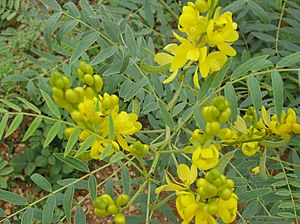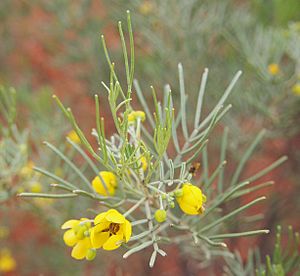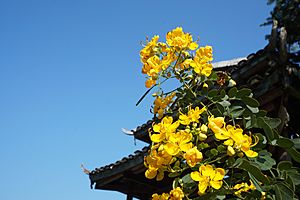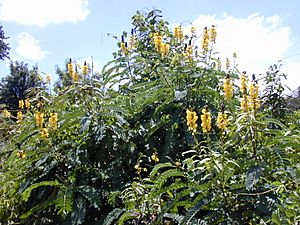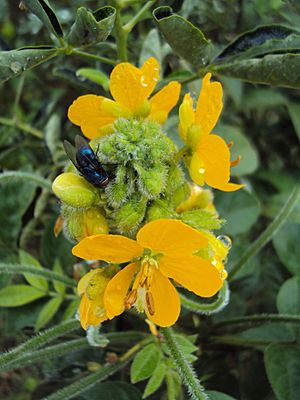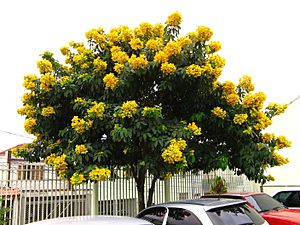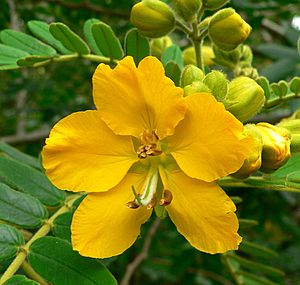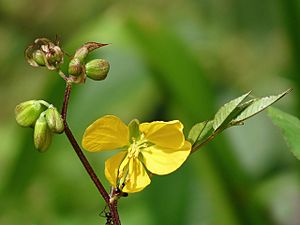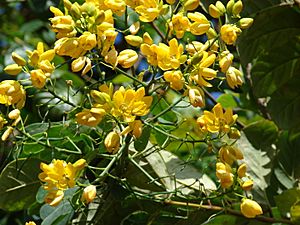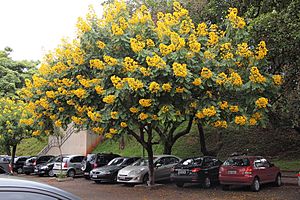Senna (plant) facts for kids
Quick facts for kids Senna (plant) |
|
|---|---|
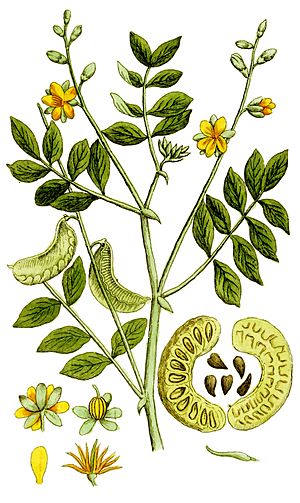 |
|
| Senna alexandrina | |
| Scientific classification |
|
| Kingdom: | Plantae |
| Clade: | Tracheophytes |
| Clade: | Angiosperms |
| Clade: | Eudicots |
| Clade: | Rosids |
| Order: | Fabales |
| Family: | Fabaceae |
| Subfamily: | Caesalpinioideae |
| Tribe: | Cassieae |
| Genus: | Senna Mill. |
| Type species | |
| Senna alexandrina |
|
| Species | |
|
Over 300; see Senna (plant) § Notes |
|
| Synonyms | |
|
List
|
|
Senna, also known as sennas, is a large group of flowering plants. They belong to the pea and bean family called Fabaceae. These plants are found all over the tropics, which are warm regions near the Earth's equator. A few types of Senna also grow in cooler, temperate areas.
Scientists believe there are about 260 to 350 different kinds of Senna plants. The most well-known type is Senna alexandrina. About 50 Senna species are grown by people. These plants are often studied because they contain many natural chemicals that are good for health. They have properties that can help fight germs and protect cells from damage.
Contents
What Senna Plants Look Like
Senna plants can be shrubs, small trees, or perennial herbs. This means they can be woody bushes, small trees, or plants that live for more than two years and have soft stems.
- Leaves: Their leaves grow in an alternating pattern along the stem. Each leaf has up to 25 pairs of smaller leaflets. At the base of each leaf, there's a small leaf-like part called a stipule. These stipules often fall off as the leaves get older.
- Flowers: The flowers grow in clusters called racemes, usually in the spots where leaves meet the stem. Each flower has five green or yellowish parts called sepals, which protect the bud. It also has five yellow petals that are usually smooth.
- Stamens: Most Senna flowers have ten stamens, which are the parts that produce pollen. These stamens are separate from each other and have different lengths. Some of them are staminodes, which means they are stamens that don't produce pollen.
- Fruit: The fruit of a Senna plant is a tough, leathery pod. Inside these pods, you'll find several seeds.
How Scientists Classify Senna Plants
Chamaecrista, Cassia, and Senna are three groups of plants that are closely related. Scientists have studied their DNA to understand these relationships. These studies show that each of these three groups is distinct. However, the exact family tree showing how they are related to each other is still being figured out.
The name Senna comes from the Arabic word sanā. This word describes plants whose leaves and pods have properties that help with digestion.
Types of Senna Plants
As of June 2023, the Plants of the World Online database lists many different types of Senna species. Here are a few examples:
There are over 300 known species of Senna plants. Some of them include:
- Senna alata – also called candlebush
- Senna alexandrina – Alexandrian senna
- Senna artemisioides – silver cassia
- Senna bicapsularis – rambling senna
- Senna corymbosa – Argentine senna
- Senna didymobotrya – candelabra-tree
- Senna hebecarpa – American senna
- Senna hirsuta – woolly senna
- Senna italica – Italian senna
- Senna multiglandulosa – glandular senna
- Senna obtusifolia – coffee-weed
- Senna occidentalis – coffee-senna
- Senna pendula – Easter cassia
- Senna siamea – kassodtree
- Senna spectabilis
- Senna surattensis
- Senna tora – sickle senna
Senna in Nature
Many insect caterpillars like to eat Senna plants. For example, the black witch moth caterpillar and different types of emigrant butterflies feed on the candle bush (S. alata).
Some Senna species have special nectar glands on their leaves or flower stalks. These glands produce a sweet liquid that attracts ants.
Pollination
Senna plants are pollinated by various types of bees. Large female bees, like those from the genus Xylocopa, are especially important. These bees use a special method called "buzz pollination."
Here's how it works:
- The flowers have two sets of stamens. Some are longer and provide pollen for the bees to eat. Others are smaller and hold the pollen needed for pollination.
- When a bee buzzes its wings, it creates vibrations. These vibrations shake the pollen out of the smaller stamens.
- The pollen then bounces off the petals multiple times before landing on the bee's back. This is called "ricochet pollination."
- The rough surface of the petals helps slow down the pollen.
- Also, flying bees build up a positive static charge, and the pollen has a negative charge. This helps the pollen stick to the bee's body.
- So, the bee carries pollen to other flowers, helping the plant reproduce, and also gets a meal from the feeding stamens.
Uses of Senna Plants
People use some Senna species as ornamental plants in gardens and parks. They are good for landscaping because they can grow in many different climates.
- Food and Thickening: A substance called Cassia gum comes from the seeds of Chinese senna (S. obtusifolia). This gum is used as a thickening agent in some foods. The leaves and flowers of Siamese cassia (S. siamea) are used in cooking in places like Southeast Asia. In Thai, they are called khi-lek and are used in curries.
- Traditional Uses: For a long time, Egyptian senna (S. alexandrina) has been used to help with digestion. It can be used as senna pods or as a herbal tea made from the leaves. It helps the body's natural process of getting rid of waste.
Senna in the Past
Scientists have found a fossil seed pod of a Senna plant. It was found in Tennessee, United States, and dates back to the middle Eocene epoch. This shows that Senna plants have been around for a very long time!
See also
 In Spanish: Senna (planta) para niños
In Spanish: Senna (planta) para niños


